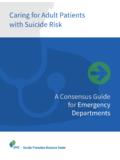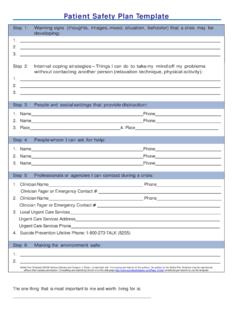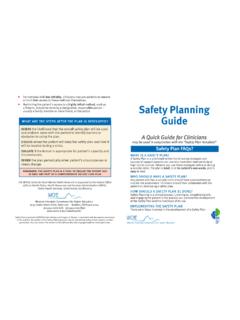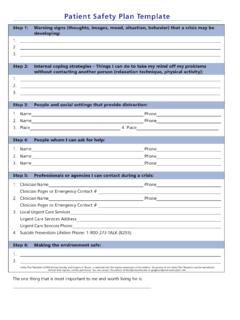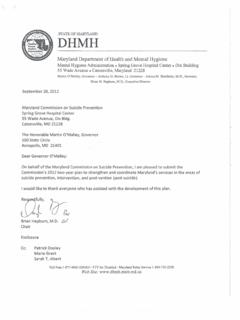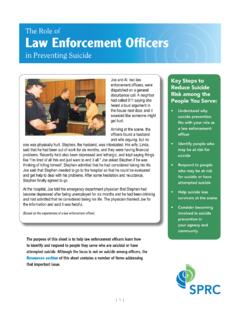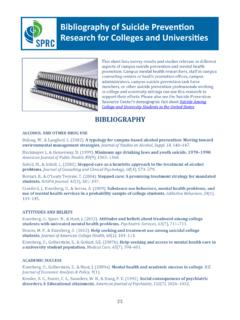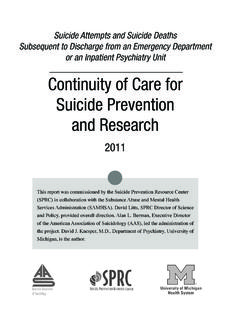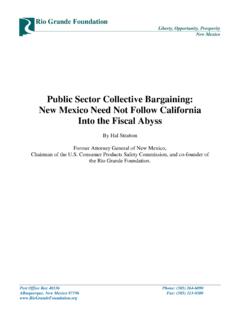Transcription of After a Suicide: A Toolkit for Schools 2nd Edition
1 After a Suicide: A Toolkit for SchoolsSecond EditionSuicide Prevention Resource CenterAfter a Suicide: A Toolkit for Schools | iiEndorsements from Other Organizations National Association of school Psychologists (NASP)When a suicide occurs, it can disrupt the foundation of the school and larger community to the core. How school leaders respond can help minimize negative effects and reinforce resilience. In fact, effective postvention efforts serve as the first line for prevention of potential suicide contagion among vulnerable members of the school community.
2 After a Suicide: A Toolkit for Schools provides step-by-step guidance, templates, and resources all in one place. It is a vital resource to help school administrators and crisis teams plan for and implement appropriate postvention strategies to facilitate communications, support grieving students and staff, identify at-risk individuals, and Association of Secondary school Principals (NASSP)The tragedy of suicide affects many Schools each year, and it is essential for principals and other school leaders to have the resources they need to help them cope personally and professionally in the event of a student death.
3 During the high-stress period After a suicide, these professionals must provide effective postvention (activities that reduce risk and promote healing After a suicide death) and facilitate an orderly return to the daily operation of the school . That s why the National Association of Secondary school Principals (NASSP) collaborates with organizations like the American Foundation for Suicide Prevention and the Suicide Prevention Resource Center. Toolkits like After a Suicide: A Toolkit for Schools provide our members with tools and resources designed to help them work with faculty, staff, students, and others to restore the health of the school community.
4 Resources like these are integral in helping principals and other school leaders carry out their mission to serve all school Counselor Association (ASCA)A student suicide has a tremendous impact on the entire school as well as the broader community. school administrators, faculty, and staff are called on to provide leadership and strength to students and their families, even though they themselves may be shaken emotionally and unsure of the proper actions to take. They will be grappling with issues such as immediate crisis response, helping students and parents cope, and communicating with the school and wider community, as well as the media.
5 After a Suicide: A Toolkit for Schools , developed by the American Foundation for Suicide Prevention and the Suicide Prevention Resource Center, is a valuable guide to help school personnel prepare for the tumultuous and stressful aftermath of a student suicide and to help prevent future a Suicide: A Toolkit for Schools | iiiAuthors of the Second EditionDoreen S. Marshall, PhD Vice President of Programs, AFSPC hristine Moutier, MD Chief Medical Officer, AFSPL aurie B. Rosenblum, MPH Research Associate/Writer, SPRCC hristine Miara, MS Former Director of Communications and Resources, SPRCMarc Posner, PhD Senior Writer/Editor, SPRCR eviewers of the Second EditionTerri A.
6 Erbacher, PhD school Psychologist, Delaware County Intermediate Unit, Morton, PA; Clinical Associate Professor, Philadelphia College of Osteopathic Medicine, Philadelphia, PAMadelyn Gould, PhD, MPH Professor of Epidemiology (in Psychiatry), Columbia University Medical Center, New York, NYJohn R. Jordan, PhD Clinical Psychologist, Private Practice, Pawtucket, RIRichard Lieberman, MA, NCSP Lecturer, Graduate school of Education at Loyola Marymount University, Los Angeles, CADavid N. Miller, PhD Associate Professor of school Psychology, Department of Educational & Counseling Psychology, University at Albany, State University of New York, Albany, NYScott Poland, EdD Professor, College of Psychology, and Co-Director, Suicide and Violence Prevention Office, Nova Southeastern University, Fort Lauderdale, FLJonathan B.
7 Singer, PhD, LCSW Associate Professor, Loyola University school of Social Work, Chicago, IL; Founder and Host, Social Work PodcastContributors of Vignettes for the Second Edition Elaine de Mello, LCSW Training and Services Manager, Connect Suicide Prevention Program, National Alliance on Mental Illness NH, Concord, NHShashank V. Joshi, MD Director of school Mental Health, Division of Child & Adolescent Psychiatry, Stanford University school of Medicine, Stanford, CASarah Estes Merrell, MA school Counselor, St. Ignatius College Prep, San Francisco, CAJeremiah Simmons, MPH, MS PhD Candidate, RWJ Fellow, Program in Clinical Psychology, Robert Wood Johnson Center for Health Policy at the University of New Mexico, Albuquerque, NMErika Zepeda, MA, MEd school Psychologist, Palo Alto High school , Palo Alto, CAThis second Edition of After a Suicide: A Toolkit for Schools was written in 2018 by the American Foundation for Suicide Prevention (AFSP) and the Suicide Prevention Resource Center (SPRC), Education Development Center (EDC).
8 After a Suicide: A Toolkit for Schools | ivAuthors of the First Edition and Their Affiliation at the Time of Publication (March 2011)AFSP Co-Chair, Joanne L. Harpel, JD, MPhil Senior Director for Public Affairs and Postvention, AFSPSPRC Co-Chair, Peggy West, PhD, MSW Senior Advisor, SPRCG ayle Jaffe, MSW, MPH Senior Prevention Specialist, SPRCD onna Amundson, LCSW Program Manager, Traumatic Loss Coalitions for Youth Program, UMDNJ-University Behavioral Health Care, Piscataway, NJPrimary Reviewers of the First EditionAnnette Beautrais, PhD Senior Research Scientist, Yale University school of Medicine, New Haven, CTKaren Dunne-Maxim, MSN, RN Everest Consulting Associates, Princeton Junction.
9 NJMadelyn Gould, PhD, MPH Professor of Clinical Epidemiology (in Psychiatry), Deputy Director of Research Training Program in Child Psychiatry, New York State Psychiatric Institute, Columbia University, New York, NYChristopher Gandin Le, MA CEO, Emotion Technology LLC, Austin, TXRobert Macy, PhD Director, International Center for Disaster Resilience and Executive Director, Boston Children s Foundation, Boston, MAElizabeth McCauley, PhD Professor of Psychiatry and Behavioral Science, University of Washington, Seattle, WAGeorge Scott, EdS, MFT Middlesex County Coordinator, Traumatic Loss Coalitions for Youth Program.
10 UMDNJ-University Behavioral Health Care, Newark, NJFrank Zenere, EdS school Psychologist and District Crisis Management Specialist, Miami-Dade Public Schools , Miami, FLFor additional first Edition acknowledgments, see Appendix C: Additional Reviewers of the First a Suicide: A Toolkit for Schools | vAfter a Suicide: A Toolkit for Schools addresses Objective of the National Strategy for Suicide Prevention (2012): Develop guidelines for effective comprehensive support programs for individuals bereaved by suicide and promote the full implementation of these guidelines at the state/territorial, tribal, and community levels.

